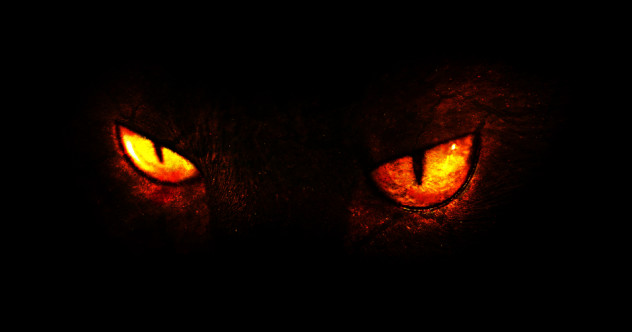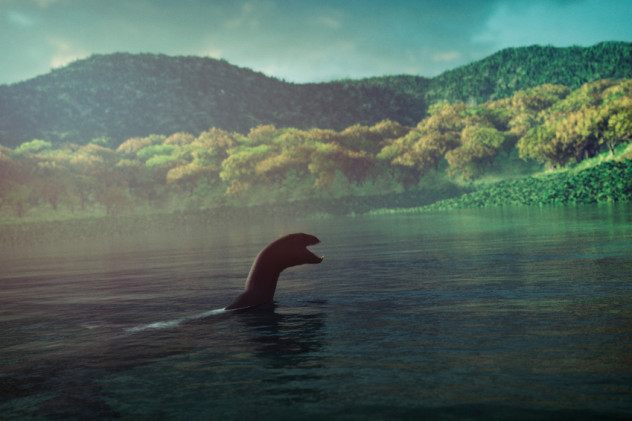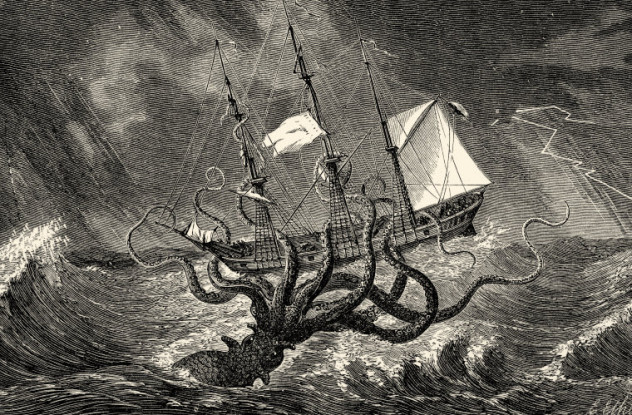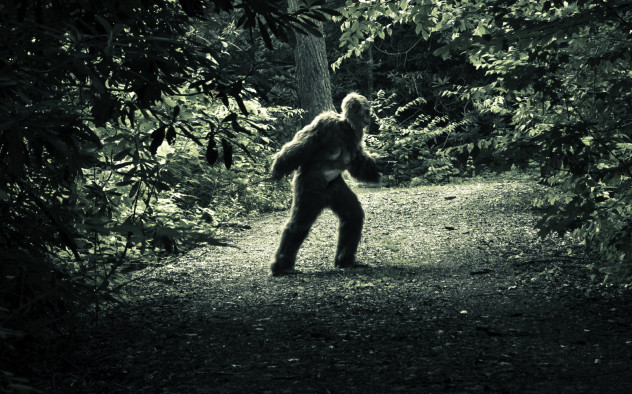 Travel
Travel  Travel
Travel  Creepy
Creepy 10 Haunted Places in Alabama
 History
History Top 10 Tragic Facts about England’s 9 Days Queen
 Food
Food 10 Weird Foods Inspired by Your Favorite Movies
 Religion
Religion 10 Mind-Blowing Claims and Messages Hidden in the Bible Code
 Facts
Facts 10 Things You Never Knew about the History of Gambling
 Weird Stuff
Weird Stuff 10 Cool and Creepy Facts about Collecting Tears
 Humans
Humans The Ten Most Lethal Gunslingers of the Old West
 Misconceptions
Misconceptions 10 Phony Myths and Urban Legends That Just Won’t Die
 History
History 10 Amazing Roman Epitaphs
 Travel
Travel Top 10 Religious Architectural Marvels
 Creepy
Creepy 10 Haunted Places in Alabama
 History
History Top 10 Tragic Facts about England’s 9 Days Queen
Who's Behind Listverse?

Jamie Frater
Head Editor
Jamie founded Listverse due to an insatiable desire to share fascinating, obscure, and bizarre facts. He has been a guest speaker on numerous national radio and television stations and is a five time published author.
More About Us Food
Food 10 Weird Foods Inspired by Your Favorite Movies
 Religion
Religion 10 Mind-Blowing Claims and Messages Hidden in the Bible Code
 Facts
Facts 10 Things You Never Knew about the History of Gambling
 Weird Stuff
Weird Stuff 10 Cool and Creepy Facts about Collecting Tears
 Humans
Humans The Ten Most Lethal Gunslingers of the Old West
 Misconceptions
Misconceptions 10 Phony Myths and Urban Legends That Just Won’t Die
 History
History 10 Amazing Roman Epitaphs
10 Unbelievable Wartime Monster Sightings
It’s often said that war is hell, but what’s hell without at least the occasional demon? Perhaps that’s why some of the most plausibility-straining monster sightings in history have been set against the backdrop of a world gone mad with violence and death.
10The U-28 Sea Crocodile

During World War I, the British steamer Iberian was cruising off the coast of Ireland when it was attacked by the German submarine U-28 (pictured above right). The Iberian tried to flee, but U-28 pursued, firing shells and torpedoes. After taking two direct hits, the Iberian tipped up and sank with her bow in the air.
The sinking would be all but forgotten today if not for an article the U-28‘s captain, Baron von Forstner, wrote for a German newspaper in 1933. In the Baron’s account, he stood on the submarine’s conning tower and watched the steamer sink. About 25 seconds after it disappeared beneath the surface, there was a large explosion, possibly caused by the ship’s boiler detonating. The blast threw a mysterious sea creature clear out of the water. “The animal was about 20 meters [65 ft] long and crocodile-like in shape, with pairs of strong front and hind legs adapted for swimming, and a long head that tapered towards the nose.” According to the Baron, the creature was visible for about “10 to 15 seconds at a distance of about 150 to 100 meters (500–300 ft) in bright sunshine.”
The Belgian zoologist Bernard Heuvelmans, who coined the term “cryptozoology” and produced an influential book on sea serpents, considered the U-28 sighting one of the four most reliable in history. The incident was especially interesting since the explosion flung the animal all the way out of the water, allowing the Baron to see its entire body. Based on his description, Heuvelmans speculated that the creature might have been a surviving species of Thalattosuchia, a genus of giant sea crocodiles from the time of the dinosaurs.
Despite Heuvelmans’ assesment, skeptics suggest that the Baron might have made the whole story up. According to his account, seven other crew members witnessed the creature. Unfortunately, six died during the war, presumably when the U-28 was sunk in 1917 (the most common story is that another sinking ship exploded, hurling a burning truck straight onto the submarine). The only surviving witness was the sub’s cook, Robert Maas, who never wrote about the incident, leaving the story to rely on von Forstner’s account alone. Additionally, the 61 survivors of the Iberian apparently didn’t see the creature. In fairness, they might have been a little busy at the time.
9The Morbach Monster

The German town of Wittlich is home to a strange legend—which might not be a legend at all, if US soldiers stationed in the area are to be believed. According to the story, a deserter from Napoleon’s army found his way to the town, where he attacked and murdered a local farmer and his wife. However, before the farmer’s wife drew her last breath, she cast a curse on the feral soldier, turning him into a monstrous wolf. Mad with rage, the creature rampaged through the countryside until a mob of townsfolk hunted it down and killed it.
The story is fairly well-known (a local American football team even called themselves the Morbach Monsters) but not particularly exceptional by the standards of werewolf lore. More interesting are the experiences of American servicemen stationed at the nearby Hahn Air Base during the Cold War. Apparently, a number of the American troops saw a mysterious wolf-like creature while patrolling the forested edges of the base.
According to two anonymous accounts collected by the University of Pittsburgh, military policemen investigating a perimeter alarm stumbled upon a “dog-like” animal, which stood up on its hind legs and looked at them. The creature then took “three long leaping steps” and jumped over a high fence (the accounts differ on the exact height of the fence, but agree that it was taller than a man). The beast then disappeared into the forest. A sniffer dog was brought in, but it went berserk with fear, refusing to track the creature.
University of Mainz anthropolgist Matthias Burgard subsequently collected several other stories from US servicemen who said they had seen strange animals or odd movements deep in the woods. One airman said he had been “stalked” by a hidden, howling beast while walking his dogs. Another witness rejected the theory that the Americans might have been startled by local wild hogs: “I grew up on a farm in the USA and this was no hog.”
Yet another serviceman offered Burgard an alternate explanation for at least some of the sightings: “It was always fun to scare the new guys with stories of the werewolf and then make them do a security check of the perimeter on foot. One of our K-9s was this big black bouvier with bloodshot eyes. We would always send that dog’s handler to meet the new guys.”
8The Hound Of Mons

In 1919, a number of Oklahoman newspapers published a terrifying story from a Canadian World War I veteran named Captain F.J. Newhouse. According to Newhouse, Allied soldiers in the trenches at Mons had found themselves hunted by a terrifying beast. It all started in 1914, when Captain Yeskes of the London Fusiliers took four soldiers out into no-man’s-land on patrol. When they didn’t return, their concerned comrades thought they might have been intercepted by the Germans. But days later, “their dead bodies were found—just as they had been dragged down—with teeth marks at the throats.”
From that point, things only got worse. Terrible howls echoed across the landscape and soldiers reported seeing strange movements beyond the barbed wire. Patrols into no-man’s-land would be found horribly mauled, as if by some great beast. Then, just as suddenly as it had appeared, the creature seemed to disappear again.
The mystery was only resolved when a German scientist named Gottlieb Hochmuller was killed in a Berlin riot at the end of the war. Apparently, Hochmuller’s papers revealed a dastardly plot to transfer a madman’s brain into a giant Siberian wolfhound, which was subsequently released into no-man’s-land. This was part of a series of experiments which Hochmuller hoped would “end the war in Germany’s favor.” How even a very crazy dog was supposed to resolve a world war remains unclear.
Interestingly, Captain Newhouse seems to have been a real soldier, but otherwise the story falls apart quite quickly. For one thing, there is no record of a scientist named Gottlieb Hochmuller and there was definitely no Captain Yeskes in the London Fusiliers. Yeskes is actually a quite rare name in England, although it’s much more common in Canada and America, suggesting that F.J. Newhouse probably made the whole thing up.
The Battle of Mons is also well known for the legend of the Angels of Mons, in which angelic beings, most commonly in the form of medieval bowmen, appeared to protect British soldiers. The legend started with a short story by the horror writer Arthur Machen, which appeared in the London Evening News in 1914. The story was written in the style of a newspaper report and wasn’t adequately labeled as fiction, prompting many people to believe it was real. The story soon took on a life of its own, to the point that people refused to believe Machen had made it up. As Machen later wrote, “the snowball of rumour that was then set rolling has been rolling ever since, growing bigger and bigger, till it is now swollen to a monstrous size.”
7The Little Bigfoot

The British zoologist John McKinnon achieved fame in the 1990s, when he helped discover three new mammals in Vietnam’s remote Vu Quang Nature Reserve. But in his 1974 book In Search Of The Red Ape, McKinnon suggested that there might be an even more extraordinary creature hiding in the rain forests of Southeast Asia.
According to McKinnon, he was trekking through the Malaysian state of Sabah when:
I stopped dead, amazed at what I saw. I knelt down to examine the disturbing footprint in the earth, a print so like a man’s yet so definitely not a man’s that my skin crept and I felt a strong desire to head home. The toes looked quite human, as did the shapely heel, but the sole was both too short and too broad to be that of a man and the big toe was on the opposite side to what seemed to be the arch of the foot.
McKinnon’s Malay boatman told him that the tracks belonged to the “forest people” or “Batatut,” but McKinnon apparently preferred not to investigate further: “I was uneasy when I found them, and I didn’t want to follow them and find out what was at the end of the trail. I knew that no animal we know about could make those tracks. Without deliberately avoiding the area I realize I never went back to that place in the following months of my studies.”
McKinnon’s experience helped bring wider attention to the legend of the Batatut, the “Little Bigfoot” that supposedly lurks in the jungles of Indochina and Borneo. Which may help explain an unusual sighting reported in Kregg P. J. Jorgenson’s book Strange But True Stories of the Vietnam War. According to Jorgenson, six unnamed American soldiers were deep in the Vietnamese jungle when they spotted a strange, ape-like creature, around 150 centimeters (5′) tall and covered in red hair, walking upright through a clearing. The soldiers speculated that it could be an orangutan, but then realized that there were no orangutans in Vietnam. Sadly, the creature quickly vanished and the 101st Airborne Division lost out on a potentially amazing new mascot.
6The Brosno Dragon

Located around 400 kilometers (250 mi) south of Moscow, Lake Brosno is a moderately sized (but surprisingly deep) body of water with a big reputation. According to legend, a fearsome horde of Tatar horsemen were on their way to sack the city of Novgorod when they decided to stop for a nice rest by the lake. Everyone was having a lovely time until a huge reptilian monster suddenly lunged out of the water and began attacking both men and horses. Taking the dragon attack as a bad sign, the Tatars decided to leave Novgorod alone and just go home instead.
That’s firmly in the realm of myth, but stories about a monster in Lake Brosno abound, essentially making “Brosnya” Russia’s equivalent of the Loch Ness monster. In 2002, a Russian UFO group organized an expedition to take sonar readings of the lake, reporting a “huge jelly-like mass” lying just above the lakebed. Since this was Russia, they immediately lobbed an explosive device at it, prompting it to start rapidly rising to the surface. Fortunately, when the team looked into the water “there was nothing resembling a monster,” thus sparing them the terrible fate of the Tatars.
Some Soviet skeptics have suggested scientific scenarios supposedly solving the serpent sightings. For example, it’s possible that hydrogen sulphide occasionally builds up at the bottom of the lake and rushes to the surface, creating an eruption of bubbles that might be mistaken for an underwater creature. Alternatively, a volcanic fracture at the bottom of the lake might eject similar gases. Or maybe some “Brosnya” sightings are just wet elk swimming across the lake. However, even a very large elk surely couldn’t have leaped from the water and swallowed a German plane whole, as Brosnya is rumored to have done during World War II.
5The Congo Snake
Colonel Remy Van Lierde was a Belgian pilot who became well-known for his heroic exploits during World War II. Among other feats, Van Lierde escaped from a German prisoner-of-war camp and made it safely to Britain, where he became an ace in the Royal Air Force. But his famous monster sighting came years later, when he was returning from a mission in the Congo. According to Van Lierde, he was flying over the jungle in a helicopter when he spotted a giant snake, “very dark green with his belly white,” which he estimated at 15 meters (50 ft) in length.
In Van Lierde’s account, the serpent reared up as though it wanted to attack the helicopter (fortunately, the Belgian wasn’t flying quite that close to the ground). He even managed to snap a picture of the beast, which is now well-known in cryptozoology circles. Unfortunately, the picture is fairly blurry and doesn’t provide anything to indicate the scale, so it can’t be used as proof that the snake really was that enormous. Still, Van Lierde stuck to his guns, insisting that the monster was a true giant and “could easily have eaten up a man” if it had wanted to.
4A Kraken

A squid-like Scandinavian sea monster, the kraken is one of the best-known mythological creatures in the world, featuring in some of the most popular Hollywood releases of recent times. But the discovery of giant squid in the depths of the ocean has led some to speculate that there might be some truth in the occasional sighting of truly enormous cephalopods.
One of the most dramatic “kraken” encounters came during World War II, when a British trawler was moored off the Maldives. Crewman A.G. Starkey was standing on deck one evening when he spotted something in the water and shone his torch on it: “As I gazed, fascinated, a circle of green light glowed in my area of illumination. This green unwinking orb, I suddenly realized, was an eye. The surface of the water undulated with some strange disturbance. Gradually, I realized that I was gazing almost point-blank at a huge squid.”
So far, that’s not totally implausible, but Starkey then claimed he walked the length of the ship, finding the squid’s head and tentacles at opposite ends. That would have made the creature 53 meters (175 ft) in length, more than three times as long as the largest giant squid ever recorded. Oddly, Starkey doesn’t seem to have called anyone else to take a look at the terrifying monster lurking near the boat, leaving his story uncorroborated.
3The Mist

For all the elaborate dragon and werewolf sightings doubtless boring soldiers the world over, sometimes the creepiest supernatural sightings leave plenty to the imagination. Take the case of Robert L. Pollock, a crew member on C-130 cargo aircraft during the Vietnam War. In an interview with The Paranomalist, Pollock related a disturbing experience while flying just off the coast of South Vietnam: “I noticed movement at the rear of the boxcar sized empty cargo compartment. I looked and was stunned to see a whirling grey cloudy mass forming at the rear right troop door. The mass was whirling clockwise; it completely filled in the entire rear of the aircraft within seconds.”
Naturally, Pollock assumed that there was a technical problem, but none could be found. Before long, the whole crew had joined Pollock and they “just continued to back away from the mass as it advanced toward the front of the aircraft.” When Pollock placed his hand inside the mist, it simply vanished from sight. Then he and the plane’s engineer decided to step inside the strange fog, finding that it completely blocked their vision, as if no light could penetrate it. But otherwise, the mist had no smell or taste and didn’t interfere with breathing. Pollock said he couldn’t even feel it.
Luckily, the problem was solved when “the mass began to go away the way it had appeared, only in reverse. When it got back to the place it had first started forming, it whirled counter-clockwise and then just disappeared into nothing.” Sensibly, Pollock and the other crew members decided to just pretend the incident had never happened and didn’t discuss it further.
2Russia’s Bigfoot

Not content with their own Loch Ness, the Russians also have their own Bigfoot-like creature. Known as the Almas, these short, ape-like men supposedly inhabit Central Asia’s rugged Pamir Mountains. One of the most famous Alma sightings came in 1925, when General Mikhail Topilski was hunting pockets of anti-Soviet resistance holding out in the area. While interrogating a captured guerrilla, Topilski was told that the rebels had supposedly been attacked by strange creatures in a nearby cave. Intrigued, Topilski decided to investigate and soon found an unusual dead body. Anthropologist Myra Shackley described it in her book Still Living:
[The body] belonged to a male creature 165–170 cm [5’5″] tall, elderly or even old, judging by the grayish color of the hair in several places. The chest was covered with brownish hair and the belly with grayish hair. In general the hair was very thick, without any under fur. There was least hair on the buttocks, from which fact our doctor deduced that the creature sat like a human being. There was most hair on the hips. The knees were completely bare of hair and had callous growths on them. The whole foot including the sole was quite hairless and was covered by hard brown skin. The hair got thinner near the hand, and the palms had none at all but only callous skin. The color of the face was dark, and the creature had neither beard nor mustache.
Unfortunately, Topilski apparently didn’t have a camera and decided not to skin the corpse as he had initially planned. Instead, he ordered his men to bury it, casually destroying the only evidence that his story wasn’t completely made up. But if the Russian Bigfoot does exist, at least we can say he doesn’t have a mustache.
1Maskelyne’s Scarecrow Monster

With all the media reports of supposed wartime monster sightings, it’s no surprise that some slightly overenthusiastic officers have tried to make their own happen. The most famous case probably occurred in the Philippines during the 1950s. Colonel Edward Lansdale was an American Air Force officer and intelligence operative who masterminded various “psy-ops” campaigns against the Communist Huk insurgents in the country. At one point, that apparently involved faking a vampire attack.
According to Lansdale’s memoirs, a Huk squadron was dug in on a hill and local troops had been unable to dislodge them. So Lansdale decided to play on local superstitions involving a shape-shifting vampire known as an aswang. “The psywar squad set up an ambush along a trail used by the Huks. When a Huk patrol came along the trail, the ambushers silently snatched the last man of the patrol. They punctured his neck with two holes, vampire-fashion, held the body up by the heels, drained it of blood, and put the corpse back on the trail.” The Huks were gone by morning.
Of course, we only have Lansdale’s word for any of this, so draw your own conclusions. An even more unlikely fake monster story comes from World War II, when the British recruited a stage magician named Jasper Maskelyne (pictured above on the far right) to bamboozle the Germans with elaborate camouflage and deceptions. That much is true, but Maskelyne still felt the need to exaggerate his exploits in his memoirs, which are generally not considered reliable.
During the invasion of Sicily, Maskelyne claimed to have created “a device which was little more than a gigantic scarecrow, about 12 feet high and able to stagger forward under its own power and emit frightful flashes and bangs. This thing scared several Italian Sicilian villages appearing in the dawn thumping its deafening way down their streets with great electric blue sparks jumping from it, and the inhabitants, who were mostly illiterate peasants, simply took to their heels to the next village, swearing that the devil was marching ahead of the invading British.” In both cases, cunning Western intelligence officers pulled off amazing scams, although whether they fooled illiterate locals or the literate book-buying public remains up for debate.
Estelle lives in Gauteng, Johannesburg. She wishes they had cooler monster sightings here.








